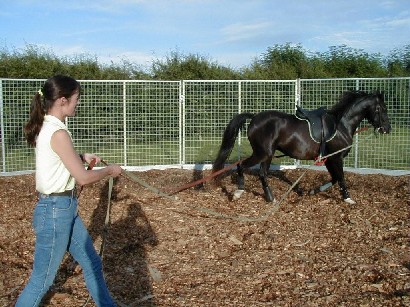
Starting under Saddle and Foundation Training
Many non professional people manage to get on their horse’s back and even
ride them around with no problems as they have a good relationship built on trust. But then there are horses that aren’t
so lucky! Some horses have badly fitted saddles girthed up too tightly too fast and when mounted, the picture looks
like a Thelwell scene but not a happy one. Or when the horse plants his feet too frightened to move, the rider misinterprets
him to be lazy and kicks the horse and then the horse often explodes!
I feel honoured to have the first ride on a horse, for at the end of the day, this beautiful flight/prey animal is
allowing a predator on his back. If the initial groundwork sessions as listed above, including saddling and bridling have
been done properly, one tiny step at a time, then the first day of being sat on/ridden should be just another interesting
learning day for the horse. As long as the horse has no physical problems e.g. sharp teeth, sore feet or back and the
horse is mentally happy, with enough turnout time, correct feed etc, then the backing process is usually a breeze.
I nearly always start them under saddle in the roundpen
as in this confined area it is easier to speed up, slow down and change direction with minimum pressure and the horse
does not need to be ‘attached’ to a person lunging him. Often I have seen horses being ridden on the lunge
with the handler having to pull the horse’s head and neck for control which causes the rider and saddle to dangerously
slip to the outside(centrifugal force)and can potentially cause harm to the horse’s neck.
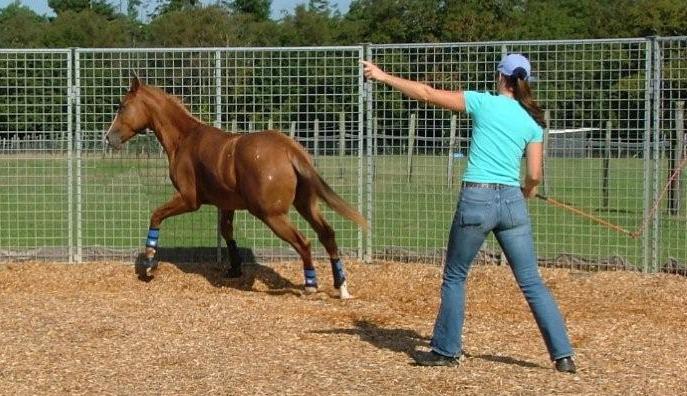
In a very short space of time, most horses I have worked in the roundpen have learnt the following
basics: walk and trot transitions, half halts, full halts, turn on the haunches, sideways movements(in prep for leg yielding),
reinback and to come back to me, all at liberty. This teaches them relaxation, rhythm, balance, coordination, impulsion,
self carriage, the responsibility to maintain gait and direction and focus(not just listening to the voice), all without the
need for side-reins or a lunge rein. Results are often attained quicker with more response and less resistance
compared to some traditional methods used in the past.
Many people use a roundpen for chasing the horse around until he gives in – this I see is a forceful way and
can ‘break’ a horse instead of ‘make’ a horse. Doing a correct Monty Roberts ‘Join-up’
or using the methods I have learnt over the 20 years from other trainers, I have found the roundpen far more valuable
than an arena for the starting process.
Once the horse
is at a competent and confident level with work in the roundpen then I will proceed to the ridden stage.
When I feel I have good control and the horse is ready, I would progress to
ridden work from the roundpen to the arena then as soon as possible, out onto the forest or field. The reason for this
is so I can use natural obstacles to teach the horse to handle himself and avoid boredom. This also helps to build a
stronger relationship working through any problems we may encounter e.g. negotiating gates, streams or fallen logs.
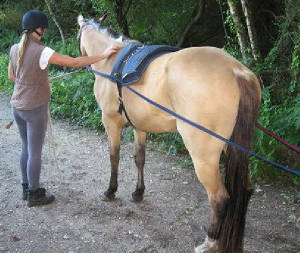
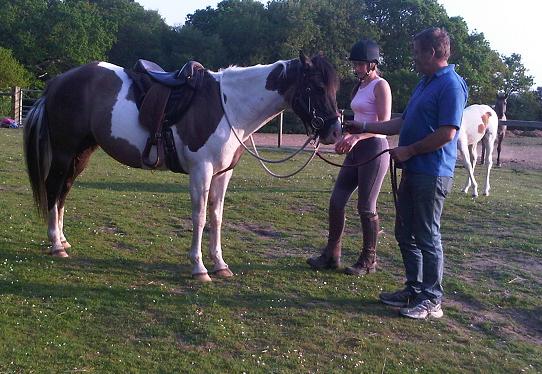
The horse’s first hack out is usually alone because although we can often use the herd instinct
to our advantage i.e. following another rider over a cross country fence, I also wish my horse to stay connected to me enough
even when he is unsure of something.
The foundation training for your horse’s chosen discipline
will vary somewhat. as a horse that has his future as a showjumper will not have to learn how to piaffe or perform a sliding
stop.
One thing is for sure, all horses need
consistency for their confidence to learn but also variety to add a little spice to their life. I believe a horse feels
better when he can not only do a few things really well but can also do many different things at a reasonable level of competence.
If your horse has a solid foundation in the basics , when he is struggling to learn something new, you can always return to
his comfort zone to get mentally and therefore physically relaxed again.
Too many of us start teaching flying changes, jumping or go out hacking on the roads before our horses are
ready. It is often difficult to slow down and stay at ‘boring’ basics when we have a talented horse but
if you put the icing on the cake before the base is cooked properly, then the icing will melt. Taking your time to do
things right first time, saves time and money in the future.
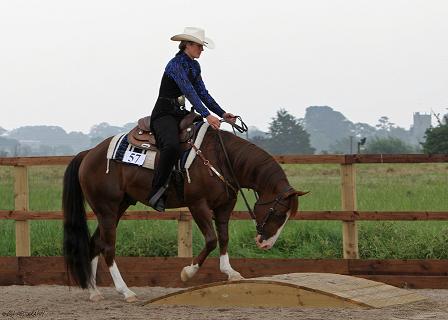
|
| Sarah successfully competing a young stallion in ridden trail |